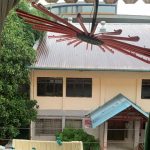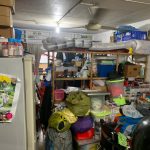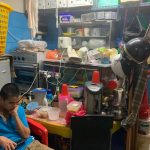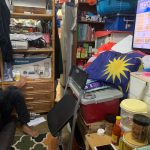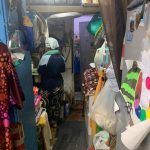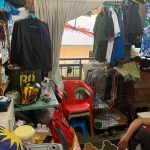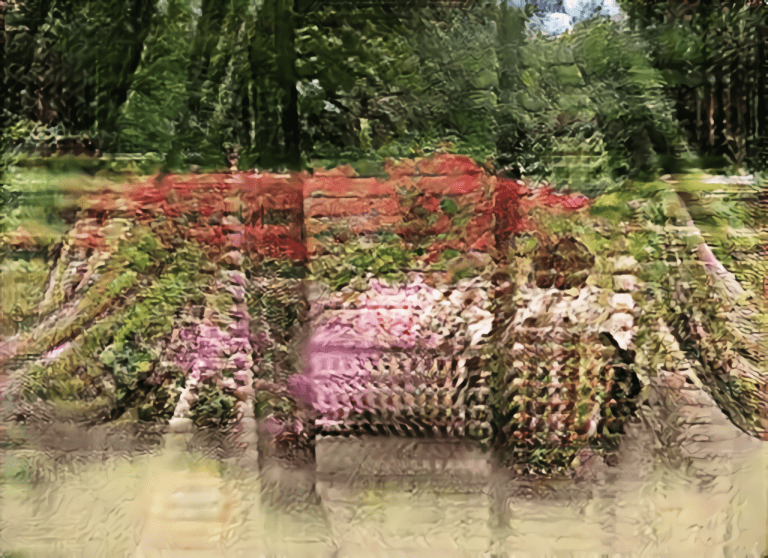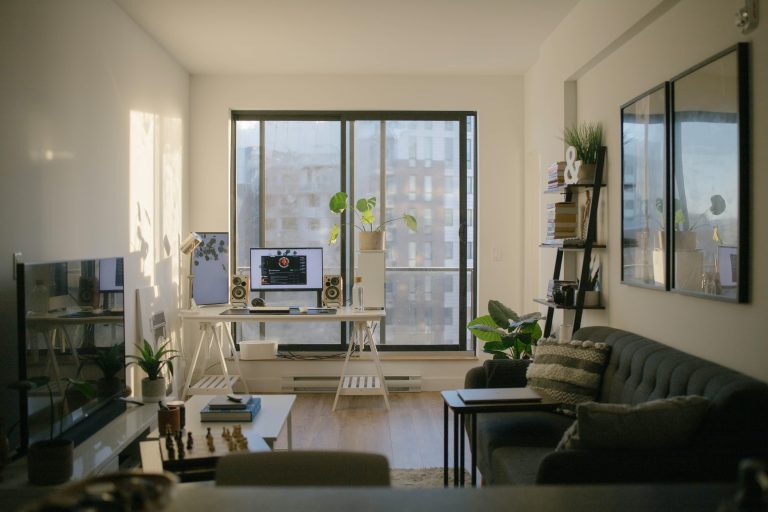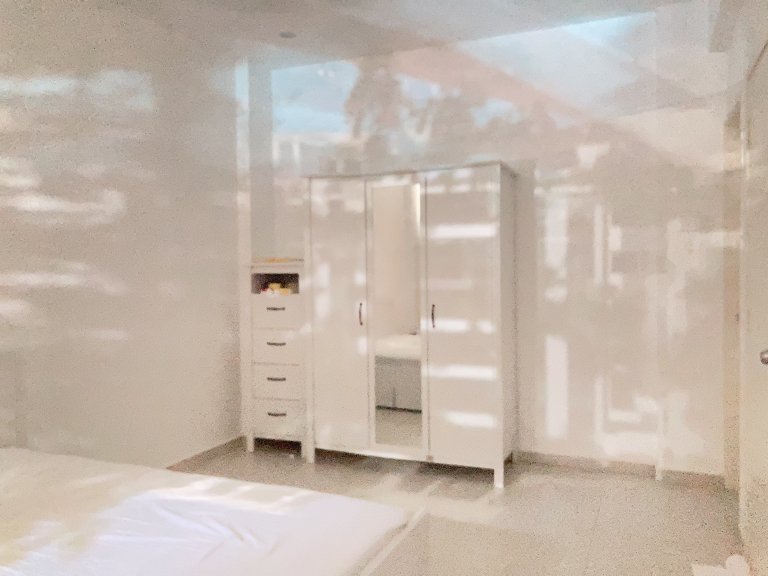Article
COMFORT AMIDST CHAOS
Imagine sharing 650 square feet of living space with twelve other family members of three generations during a nationwide lockdown due to a pandemic. A single unit flat on the 11th floor of a 17-story housing block occupying a total of 2380 units. At any given time, the total number of occupants of the whole housing area of 12 blocks, could easily reach nearly 16,000 residents. The functionality of the living room, kitchen, and bedrooms have all become indistinct due to the cramped spaces, bursting at the seams of two decades worth of necessities and belongings.
The outside view was not visible due to the cramped spaces
It has been nearly two years since the Covid-19 pandemic reared its ugly head and caused chaos in its path all over the world.
Daily routines have been disrupted, and one of the glaring impacts is on the mental health issues which have shown an alarming increase among the world’s population, including Malaysia.
The social distancing measure had inevitably induced undesirable psychological responses from the public. In the past months, the local news has reported an increase in the number of people who visited the health clinics to undergo a mental health assessment. The Malaysian government has admitted an increase in mental health cases as 35,000 distress calls were made to the Health Ministry’s Psychological Helpline between March and October 2020.
A typical view from a low-cost flat in Kuala Lumpur
Coping with stress is important for survival and can be defined as the process of managing external or internal demands that are perceived as taxing on personal capacities and resources [1]Rout, U. & Rout, J. (1993). Stress and general practitioners. Kluwer Academic Publishers..
Many efforts were made to address the issue of mental health in the wake of the pandemic.
As the unpredictable situation of the pandemic continues, the social, mental, and emotional well-being of the populations are to be affected as well. The heavily impacted groups are among those who live in the high-rise low-cost flats located in the bustling and congested urban areas throughout the country. A 2018 report from the Malaysian Ministry of Housing and Local Government stated that there is an estimation of 118,310 units of low-cost housing in the country [2] Portal Rasmi Kementerian Perumahan dan Kerajaan Tempatan. https://www.kpkt.gov.my/index.php/pages/view/256. Retrieved on 4 June 2021. .
A little peek to the outside.
Many studies had been done regarding the psychological response and mental health of individuals being quarantined, in lockdown, and isolated during a pandemic outbreak such as severe acute respiratory syndrome (SARS) and H1N1 [3]Bai, Y. M., Lin, C. C., Lin, C. Y., Chen, J. Y., Chue, C. M., & Chou, P. (2004). Survey of stress reactions among health care workers involved with the SARS outbreak. Psychiatric Services, 55(9), … Continue reading [4]Wang, Y., Xu, B., Zhao, G., Cao, R., He, X., & Fu, S. (2011). Is quarantine related to immediate negative psychological consequences during the 2009 H1N1 epidemic? General Hospital Psychiatry, … Continue reading.
In June of 2021, a quick check using the search engine Google Scholar with both keywords: mental health and Covid 19has yielded a total of 932,000 results.
Taking a cue from the words of Roy T. Bennet: “When we listen with curiosity, we don’t listen with the intent to reply. We listen for what’s behind the words”, a survey using telephone interview was conducted at a number of selected low-cost flats in Kuala Lumpur in the month of April 2020. The main objective was to obtain a first-hand experience of how the lockdown has impacted the residents living in the government’s low-cost housing schemes.
The lockdown has proven to bring with it heavy impacts to a majority of the residents living in the flats. Under normal circumstances, the small living spaces can be tolerated as many spend their day out at work or in school. When the pandemic hits, complete pandemonium was seen throughout the country.
The ability to stay at home promotes a sense of comfort and control where one can safeguard oneself from becoming another Covid19 dataset [5]Afdallyna, H. (2021). Online. Available: TBA. However, many families living at the low-cost flats were forced to confine themselves and spend most of the day indoors surrounded by four thin walls which, unfortunately, provide little privacy from the prying ears of adjacent neighbors. As for the children, the narrow corridors of the apartments most of the time served as ‘classrooms’ for them as they tried to get the best Wi-Fi coverage for their online learning. To add to the misery, the children also had to fight for the extra spaces at the corridors as it also served as the drying area of the residents.
The fight for living spaces
The functionality of the living room, kitchen, and bedrooms have all become indistinct due to the cramped spaces
Covid-19 as such has become a constellation of designing ideas that inspire creativity when seeking solutions and innovating new things [6]Mohd Shahrudin, A.M. (2021). Covid-19 as a Biopolitics? Between Digital Contagions & Social Complexity. Online. Available: TBA.
What could be done to better prepare for future lockdowns?
A drastic approach to make indoor and outdoor spaces tolerable and as a place of comfort has to be taken.
The specification from the National Housing Standard for Low-Cost Flats which allocated 130 square feet per resident has proven to be outdated and could no longer accommodate the needs and provide comfort to the residents. The term ‘comfort’ can be applied to describe the physical, psychological, and emotional condition. If a change occurs that produce uncomfortable living conditions, the occupants will behave in ways that tend to restore their comfort or minimize discomfort. If comfort is not achieved to the acceptable level, the occupants’ physical, emotional, and mental wellbeing can become compromised [7]Nazrita, I. (2021). Comfort behavior of occupants during the pandemic time. Online. Available: TBA.
One way to help elevate comfort is through exposure to outdoor greenery. In the context of comfort behavior, visual comfort describes a subjective reaction to the quality and ambiance of the lighting, the availability of an outdoor view that allows connection with nature, and the clutter-free space that makes one feel relaxed. The second concept of visual comfort is the outdoor view which connects the occupants to nature [8] Eltarabily, S. & Elghezanwy, D. (2020). Post-Pandemic Cities – The Impact of COVID-19 on Cities and Urban Design. Architecture Research 2020, 10(3): 75-84. DOI: 10.5923/j.arch.20201003.02 . Green outdoor spaces should now be seen as essential for the mental and physical health of the public. Sadly, the ugly scenario faced by the majority of those living in the low-cost housing schemes in Malaysia is that most of the flat units were not designed with balconies to provide a respite from the view outside.
If comfort is not achieved to the acceptable level, the occupants’ physical, emotional, and mental wellbeing can become compromised.
Studies show that people tend to be healthier and happier and can enjoy longer lives in areas where they have access to nature, including green urban spaces.
Nature also has a positive impact on our brains.
This is seen in those who live in places of green abundance who claimed to have better mental health.
People living close to trees and green spaces are less likely to be obese, inactive, or dependent on anti-depressants. Nature is beneficial for our mental well-being as numerous scientific studies tell us. Evidence synthesis showed strong evidence for significant positive associations between the quantity of green space and perceived mental health as well as evidence for an association with perceived general health. Even a small change in terms of a balcony that can provide many opportunities for multiple green-related/outdoor activities such as gardening and socializing areas can make a difference.
Four key aspects could be considered to create comfort for living spaces which have been practiced in the design of restorative outdoor spaces. Creating a sense of control, create spaces for social support, create physical movement and opportunity for exercise and, providing natural attractions.
Despite the technological advancement of this country, many still live in dire situations. Buildings should be built to be the secret weapon in the face of infectious diseases [9]Eltarabily, S. & Elghezanwy, D. (2020). Post-Pandemic Cities – The Impact of COVID-19 on Cities and Urban Design. Architecture Research 2020, 10(3): 75-84. DOI: 10.5923/j.arch.20201003.02. Unfortunately, the pandemic strike has highlighted the sad situation of those living in low-cost flats built a few decades ago.
The road to mental health recovery will be slow but hopefully, relevant institutions will take serious action. This is because, if the pattern as portrayed by [10] LePan, N. & Routley, M. (2020). History of deadliest pandemics- Visualizing the History of Pandemics. Visual Capitalist, COVID-19 2020 May 12,2020]. … Continue reading [Figure 1] persists, we might be looking at another pandemic in the next few years.
Instead of tracking my driving on the road, I am now keeping a track of my daily footsteps on Health app, as I feel the need to increase my physical movement since I’m always inside my home. Research shows that fitness app download grew by 46% worldwide in the first half of 2020.
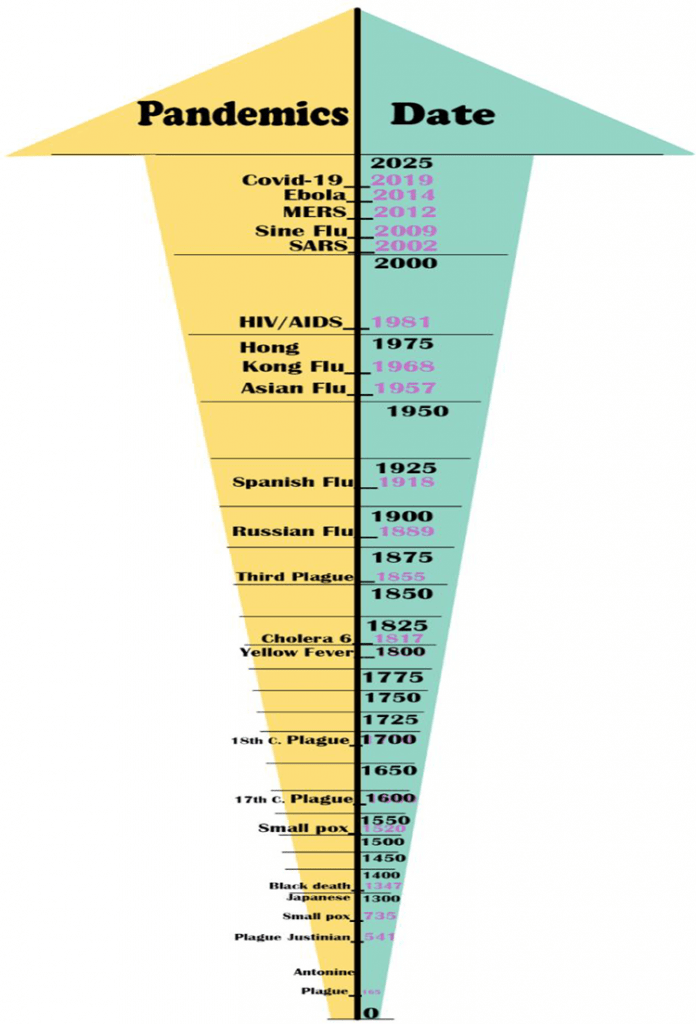
Images used in this articles
References[+]
| ↑1 | Rout, U. & Rout, J. (1993). Stress and general practitioners. Kluwer Academic Publishers. |
|---|---|
| ↑2 | Portal Rasmi Kementerian Perumahan dan Kerajaan Tempatan. https://www.kpkt.gov.my/index.php/pages/view/256. Retrieved on 4 June 2021. |
| ↑3 | Bai, Y. M., Lin, C. C., Lin, C. Y., Chen, J. Y., Chue, C. M., & Chou, P. (2004). Survey of stress reactions among health care workers involved with the SARS outbreak. Psychiatric Services, 55(9), 1055–1057. https://doi.org/10.1176/appi.ps.55.9.1055 |
| ↑4 | Wang, Y., Xu, B., Zhao, G., Cao, R., He, X., & Fu, S. (2011). Is quarantine related to immediate negative psychological consequences during the 2009 H1N1 epidemic? General Hospital Psychiatry, 33(1), 75–77. |
| ↑5 | Afdallyna, H. (2021). Online. Available: TBA |
| ↑6 | Mohd Shahrudin, A.M. (2021). Covid-19 as a Biopolitics? Between Digital Contagions & Social Complexity. Online. Available: TBA |
| ↑7 | Nazrita, I. (2021). Comfort behavior of occupants during the pandemic time. Online. Available: TBA |
| ↑8 | Eltarabily, S. & Elghezanwy, D. (2020). Post-Pandemic Cities – The Impact of COVID-19 on Cities and Urban Design. Architecture Research 2020, 10(3): 75-84. DOI: 10.5923/j.arch.20201003.02 |
| ↑9 | Eltarabily, S. & Elghezanwy, D. (2020). Post-Pandemic Cities – The Impact of COVID-19 on Cities and Urban Design. Architecture Research 2020, 10(3): 75-84. DOI: 10.5923/j.arch.20201003.02 |
| ↑10 | LePan, N. & Routley, M. (2020). History of deadliest pandemics- Visualizing the History of Pandemics. Visual Capitalist, COVID-19 2020 May 12,2020]. https://www.visualcapitalist.com/history-of-pandemics-deadliest/. |
Other Articles
Collective Behaviour in the Time of Pandemic: Living Alone in Digital Dwelling by Nasir Baharuddin PreText The Covid-19 pandemic has caused many people to live in an ambiguous norm situation. People today are either searching to recover or are found to be recorded with uncertainty, while fitting the new norm of living amidst the pandemic […]
COMFORT (and the lack of it) FOR THE URBAN POOR DURING PANDEMIC by Nazrita Ibrahim On the 25th of January 2020, the first case of COVID-19 was detected in Malaysia by three Chinese nationals who have been in close contact with a positive COVID-19 patient in Singapore [1]“[Breaking] 3 coronavirus cases confirmed in Johor Baru,” […]
Presence with Absence: Anecdote on Non-Participatory Digital Participation in a Pandemic by Afdallyna Harun For most people, the sense of presence is a comforting percipience. Presence embodies the value of existence, occurrence, companionship, empowerment, and transformation [1]Dufva, T., & Dufva, M. (2019). Grasping the future of the digital society. Futures, 107, 17-28. in other words, it is […]
Behavior Analytics on Energy Consumptions by Puteri NE Nohuddin Space and behaviour are deemed to have a significant impact on how humans interact with their surroundings. Due to this, the Movement of Restriction Order (MCO) during the COVID-19 pandemic has ignite a great deal of public outrage and grievances. As a consequence, it has affected […]
COVID-19 as a Biopolitics?: Between Digital Contagions & Social Complexity by Mohd Shahrudin Abd Manan Monologue: Is COVID-19 simply about a biological pandemic? Or is it more than that: did COVID-19 turn out to be a Black Swan that disrupts our very fundamental societal structure? If that is the case, shall COVID-19 be treated as […]
COMFORT AMIDST CHAOS by Dr. Shureen Faris Abdul. Shukor Imagine sharing 650 square feet of living space with twelve other family members of three generations during a nationwide lockdown due to a pandemic. A single unit flat on the 11th floor of a 17-story housing block occupying a total of 2380 units. At any given […]
Collective Behaviour in the Time of Pandemic: Living Alone in Digital Dwelling by Hanif Baharin Introduction At the time of writing, Malaysia is in its third lockdown (also known as Movement Control Order 3.0 or MCO 3.0), to control the Covid-19 pandemic. A study conducted in April 2020 by Dr. Shureen Faris, shows that the […]
